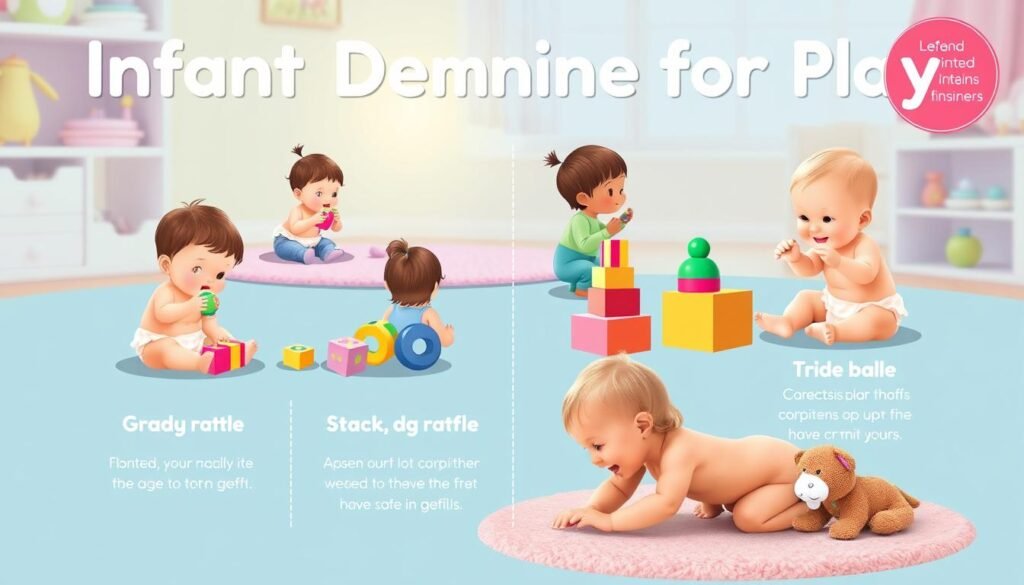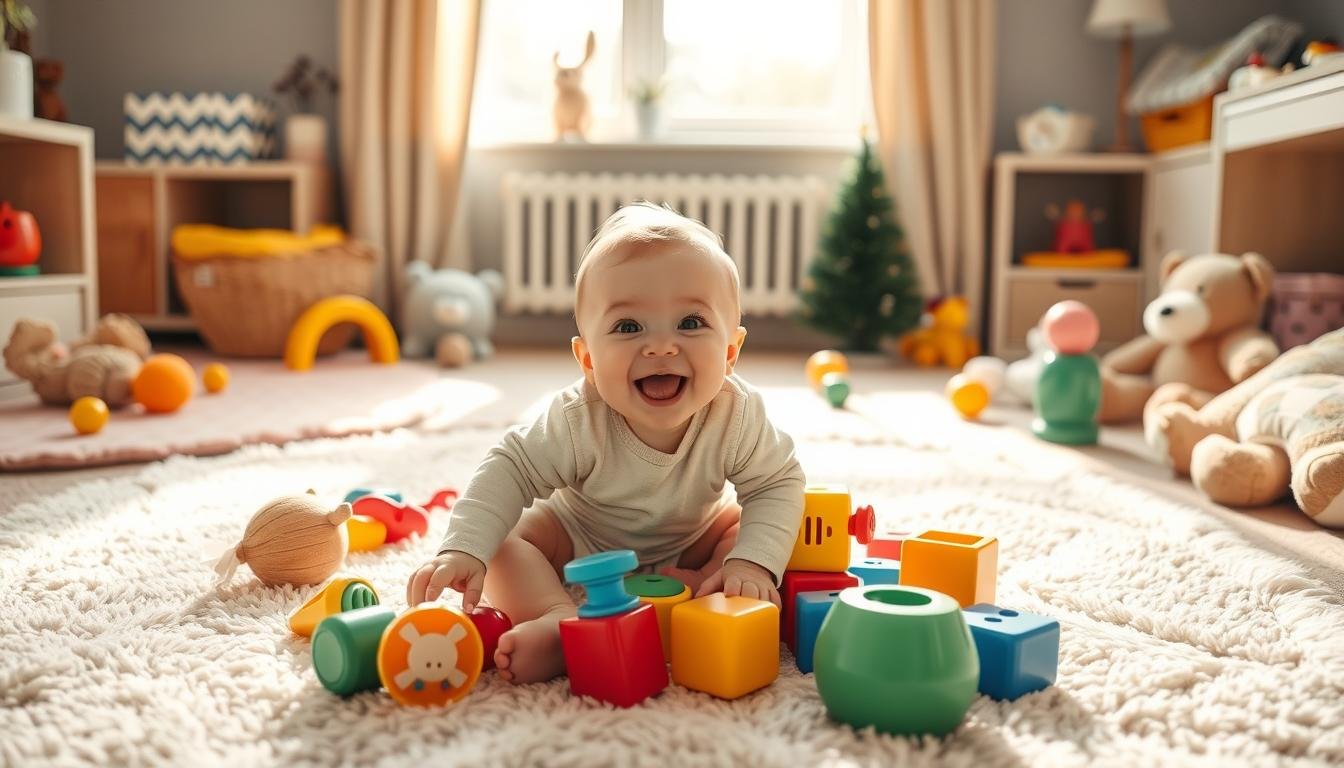As a new parent, you’ve probably wondered when your baby will start playing with toys. The journey of playtime is key to your child’s growth. We’ll explore the stages of play, from the earliest days to toddlerhood. We’ll also look at the importance of toys and activities that support development1.
Imagine your newborn, just a few days old, resting in your arms. Then, their eyes start to flutter, and a tiny hand reaches out. This moment marks the start of their journey into discovery and play2.
Key Takeaways
- Infants start playing and interacting with toys from birth, with their skills growing fast in the first few years.
- Right toys and activities help an infant’s physical, cognitive, and emotional growth at each stage.
- Newborns have limited vision and movement, but can enjoy simple, high-contrast toys and sensory experiences.
- As infants grow, they move from simple play to more complex activities like pretend play and problem-solving.
- Parents play a big role in helping a child grow through play.
Understanding Infant Playtime: A Developmental Journey
Birth to One Month: Exploring the World Through Senses
In the first month, babies mainly use their senses to learn about the world. They can see things only about 25 cm away. Toys or objects that are brightly colored and close to their face catch their eye3.
Facial expressions, voice, and touch are key for their communication and emotional growth4. Newborns love to hold onto things and explore different textures, sounds, and sights. Toys like rattles, mirrors, and soft music help stimulate their senses and prepare them for future play3.
By week one, babies can tell who is speaking to them4. In their second week, they focus on objects 8 to 14 inches away4. Around week three, they start to cuddle4. At one month, they move more smoothly, smile, and can lift their head4.
“Sensory exploration is the foundation for a child’s early learning and cognitive development. Providing a variety of stimulating toys and engaging with infants through touch, sound, and sight helps foster their understanding of the world around them.”
| Infant Development Milestones | Age |
|---|---|
| Recognize familiar voices | 1 week |
| Focus on objects 8-14 inches away | 2 weeks |
| Start snuggling | 3 weeks |
| Make smoother movements, smile, and lift head | 1 month |
As babies grow, they hit new milestones that change how they play and learn. Choosing toys that match their age and stimulate their senses is key. It helps them grow and learn in their first year of life34.
When Do Infants Play with Toys? A Comprehensive Timeline
As infants grow, their playtime changes. They start to show interest in toys. From 2-4 months, they hold and play with toys on their own. They enjoy toys that make sounds5.
Between 4-6 months, they get better at using their hands and eyes. They can pass toys and lift them to their mouths5. Teething toys become important during this time too.
From 6-9 months, babies can sit and play with objects. Toys that help them crawl, stand, and understand object permanence are great5.
By 12-15 months, babies think and learn faster. They enjoy toys that show cause-and-effect, puzzles, and stacking toys5.
Sensory toys with different textures, colors, and sounds are key. They help babies grow their senses and develop6. The CDC Milestone Tracker app offers tips for each age. It helps because babies grow at different rates6.
| Age Range | Developmental Milestones | Recommended Toys |
|---|---|---|
| 2-4 months |
|
Cause-and-effect toys, rattles, baby mirrors |
| 4-6 months |
|
Teething toys, stacking cups, soft blocks |
| 6-9 months |
|
Push-and-pull toys, shape sorters, textured balls |
| 12-15 months |
|
Puzzles, building blocks, push-and-pull toys |
Sensory toys are vital for babies’ growth. They help babies develop their senses and grow6. By age three, 80% of a child’s brain is developed6. Babies may start making sounds by 6 months6. Some say their first words like “mama” and “dada” around their first birthday6.

“The CDC Milestone Tracker app provides activities and learning tips for each age, as children develop at different rates and not all reach specific milestones by a certain age.”6
As infants grow, their playtime changes. They become more interested in toys. Knowing this timeline helps parents choose the right toys for their child’s development.
Conclusion
Playtime is key for an infant’s growth and toys are important in this journey. Understanding milestones and toys helps us give them the tools to explore and learn7.
From simple rattles to interactive dolls prams, the right toys matter a lot. They help in nurturing a child’s mind, body, and feelings8. Newborns sleep a lot, so introducing playtime helps stimulate their senses and meets their needs7.
Playtime has many benefits, like improving planning and social skills. The American Academy of Pediatrics (AAP) supports playtime, but doesn’t specify how much7. By watching our children and adjusting our play, we help them grow and thrive7.
FAQ
When do infants start playing with toys?
How does infant playtime develop over time?
What types of toys are best for infants at different ages?
How does play impact an infant’s development?
When should parents introduce toys to their newborn?
Source Links
- Good Toys for Young Children by Age and Stage – https://www.naeyc.org/resources/topics/play/toys
- Learning, Play, and Your Newborn (for Parents) – https://kidshealth.org/en/parents/learnnewborn.html
- When Do Babies Start Playing With Toys? – https://www.whattoexpect.com/first-year/milestones/when-babies-start-playing-with-toys
- A Week-by-Week Guide to Your Baby’s First Year Milestones – https://www.parents.com/baby/development/growth/baby-development-week-by-week/
- Developmental milestones for baby – https://www.marchofdimes.org/find-support/topics/parenthood/developmental-milestones-baby
- Infant Development & Milestones – https://www.michigan.gov/mikidsmatter/parents/infant/milestones
- How much interaction and playtime newborns and babies need – https://www.babycenter.com/baby/baby-development/how-much-do-i-have-to-play-and-interact-with-my-baby-do-babi_6882
- Cognitive Development: Infants and Toddlers – https://www.virtuallabschool.org/infant-toddler/cognitive-development/lesson-2

